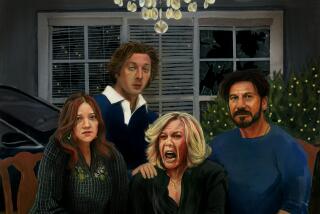The Family That Watches Together . . . : Film: Barry Levinson’s ‘Avalon’ shows the sad consequences of the Krichinskys’ addiction to TV.
- Share via
He sank into the screen. That’s how Jerzy Kosinski describes the protagonist in “Being There,” his novel about the darkly humorous rise in stature of a dull-witted, illiterate man named Chance who spends half his time gardening, the other half watching television.
Less a couch potato than a couch sponge, Chance absorbs everything on the screen, becoming whatever is before him, changing himself by changing channels. His brain contains no thoughts, only impressions. For Chance:
“The set created its own light, its own color, its own time. It did not follow the law of gravity that forever bent all plants downward. Everything on TV was tangled and mixed and yet smoothed out: night and day, big and small, tough and brittle, soft and rough, hot and cold, far and near.”
Chance is not us, not quite yet.
However, there is something ominously familiar about him, for as we enter the ‘90s, we can honestly say that just about all of America is sinking into the screen.
The A.C. Nielsen Co. estimates that Americans average four hours daily--perhaps two-thirds of their leisure time, not counting weekends--in front of the TV set. And with the coming global expansion of cable, the rest of the world may soon follow suit.
Just what this means we may not know until it’s too late to stop it.
But there are some dark implications in “Avalon,” Barry Levinson’s just-released semi-autobiographical movie about his family and upbringing in Baltimore.
This is not his first movie to touch on TV. There are comic references to TV in both “Diner” and “Tin Men,” each in a small way suggesting the intimacy of the medium and the way it weaves itself through our lives, becoming our common folkore. And the severely autistic Raymond in “Rain Man” simply cannot get through a day without watching “People’s Court,” indicating that TV can be experienced without really being experienced .
For a grimmer view, however, try “Avalon.” It’s not only an intriguing story about the dissolution of a family, but an instructive one for those Americans--now the majority--whose entire lives are spanned by TV. Just how much has TV changed our lives?
Levinson provides a before and after.
Although the movie’s cultural and generational conflicts flow from the 1914 arrival in America of a character based on Levinson’s Russian-immigrant grandfather, “Avalon” takes place mostly in the 1950s, evolving simultaneously with the evolution of TV. Although this heartfelt homage to Levinson’s childhood is hardly about TV, he uses TV as a roadmap and makes it responsible, along with suburbia, for breaking up this eclectic clan of Krichinskys.
At first the references are humorous.
There is that day all families of the era recall: The first TV set is purchased and positioned against a living room wall where it can be revered. The occasion of The First Set is so epic for the Krichinskys that the entire extended family squeezes together in front of the brown console and stares vacantly at a black-and-white test pattern, as if waiting for a curtain to rise.
Thereafter, the flickering pictures and sounds from TV--from Howdy Doody to “Studio One” to ancient movie cartoons shifted to the small screen--become the family’s constant background buzz.
Ultimately moving to the foreground.
At one point a squabble ends abruptly when everyone flies to the set upon hearing the familiar opening for Milton Berle’s “Texaco Star Theatre”: “Oh, we’re the men of Texaco, we work from Maine to Mexico. . . .”
TV now looms larger and larger.
The Krichinsky family that ate together had always talked together. These weren’t profound discussions about literature, politics or the great issues of the day. But at the very least this circle of chattering and bickering was a way of communicating, what the grandfather terms “dinner talk.”
However, “dinner talk” vanishes as the years go by, and later we see the family silently taking their meals on TV tables, glazed eyes fixed on the screen, chattering and bickering now coming only from the set.
An especially devastating metaphor comes still later, when someone is seated in a darkened room, seemingly unaware that off to the side a TV set is turned on and that the picture is mostly static. More of the constant buzz.
The grandfather in “Avalon” is an oral historian, mesmerizing children with stories of earlier times, of coming to America on the Fourth of July and being dazzled by the fireworks, of meeting his wife and making his way in Baltimore with his brothers in the paperhanging business, of living in the old neighborhood, of trying to assimilate into a culture he never fully understands.
One generation learning from another. But in an age when TV fractures the attention spans of its viewers, few children have the time or patience for such stories of family history. Now it’s TV that mesmerizes them.
More to Read
Only good movies
Get the Indie Focus newsletter, Mark Olsen's weekly guide to the world of cinema.
You may occasionally receive promotional content from the Los Angeles Times.










